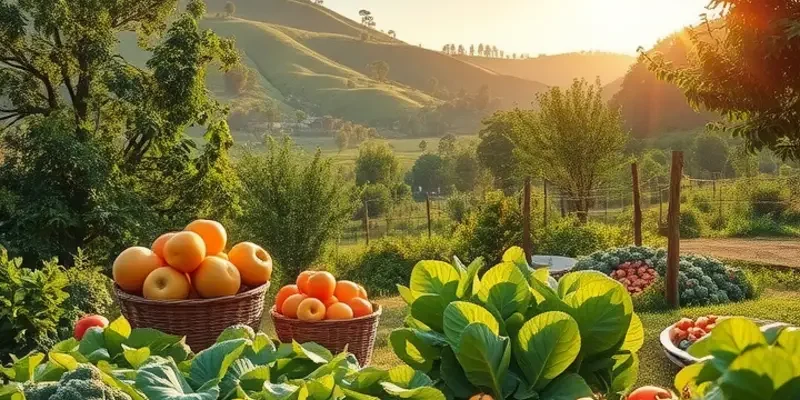Every bite we take has an ecological footprint that extends beyond our immediate surroundings. With water scarcity becoming an increasingly pressing global issue, our food choices can significantly impact water conservation. Understanding and implementing water-saving food choices fosters a sustainable lifestyle that nurtures both our bodies and the planet. Here, we delve into effective strategies to empower you to embrace a diet that not only nourishes you but also conserves this vital resource.
Understanding Food and Water Connections

Water is an essential resource vital for life, yet it’s increasingly scarce in many parts of the world. The nexus between food production and water consumption is profound. Each step in the food supply chain requires water, from growing plants to processing and packaging food products. This chapter unravels how our dietary choices impact water usage and highlights potential paths to more sustainable consumption.
Every type of diet carries a unique water footprint—the total volume of water used to produce the food consumed. Animal-based diets typically require more water than plant-based diets, largely due to the water-intensive nature of raising livestock. For instance, the water needed to produce one pound of beef is significantly higher compared to most plant-based foods.
While it may seem that plants should always be the more water-efficient choice, the reality is nuanced. Certain crops, such as almonds and avocados, demand high water inputs, especially in regions where water is already scarce. Thus, even within plant-based options, choosing locally-grown or seasonal produce can substantially reduce indirect water consumption.
To illustrate, consider the concept of ‘virtual water’—the hidden flow of water when food is traded from one place to another. Consuming foods that are grown far from your location might mean supporting water-depleting agriculture elsewhere. Choosing local or regionally appropriate crops can help decrease this environmental strain.
Individual food items also contribute differently to water usage. Animal products like cheese and leather also hold high water footprints due to the resources needed to raise animals. Comparatively, cereals and vegetables tend to need less water, making them generally more sustainable options.
Reducing water depletion isn’t just about cutting back on specific foods but also involves understanding how we store and prepare them. Practicing mindful storage and reducing waste can significantly impact water conservation on an individual level. Check out this guide for eco-smart kitchen storage tips that can minimize waste and water usage.
Ultimately, shifting towards a more water-conscious diet requires awareness and intentionality. Small changes, like choosing plant-based meals a few times a week, preferring local and seasonal produce, and optimizing food storage, collectively add up to significant savings in water usage. By making informed decisions, we can contribute to alleviating water scarcity and promote a more sustainable food system.
Choosing Water-Efficient Foods

Selecting foods that require minimal water for production is a critical step in adopting a sustainable diet. Understanding the water needs of various food types can help make informed decisions that align with eco-friendly goals.
Plant-based diets generally use less water compared to diets high in animal products. For instance, producing a kilo of beef can require over 15,000 liters of water, whereas the same weight in vegetables like tomatoes or cucumbers may only require a few hundred liters. This significant difference underscores the environmental benefit of incorporating more plant-based meals into your dietary routine. Such a shift not only conserves water but also reduces the ecological footprint associated with meat production.
Incorporating more legumes, grains, and seeds into your diet can also lead to substantial water savings. Foods like lentils and chickpeas are nutrient-dense and versatile, offering protein-rich alternatives that are less water-intensive. Grain choices such as quinoa instead of water-hungry rice can make a notable difference as well. Additionally, acknowledging the broader benefits of plant-based eating can further motivate this dietary change, as explored in this guide on easy plant-based eating.
Local produce tends to be a more water-efficient choice. Transporting food across long distances consumes resources and energy. Seasonal local produce not only supports the regional economy but often requires less packaging and refrigeration. Additionally, local foods are typically harvested closer to peak ripeness, resulting in fresher, more nutrient-packed options. Checking with nearby farmers’ markets or community-supported agriculture (CSA) programs can be a practical way to access local produce.
Eating seasonally aligns your diet with nature’s cycles and can lead to reduced water usage. Seasonal foods are grown with less need for artificial irrigation, as they rely on the natural rainfall patterns of the region. When you prioritize seasonal growth, you decrease dependency on water-intensive out-of-season farming practices.
Understanding and practicing these principles of water-efficient food choices can significantly impact global water resources. By intentionally selecting plant-based, local, and seasonal foods, you contribute to a sustainable future. With our collective dietary choices, we hold the power to make a substantial difference for the planet, one meal at a time.
Final words
Making water-saving food choices fosters a sustainable lifestyle that goes beyond personal health – it significantly contributes to global water conservation efforts. By understanding the relationship between food and water, and making conscious choices, every individual can have a positive impact on the environment. Embrace plant-based options, prioritize seasonal and local produce, and get creative with your meals to reduce water usage. Remember, each small change contributes to a larger movement towards a sustainable future, and together, we can nourish ourselves while preserving our planet’s precious resources.








